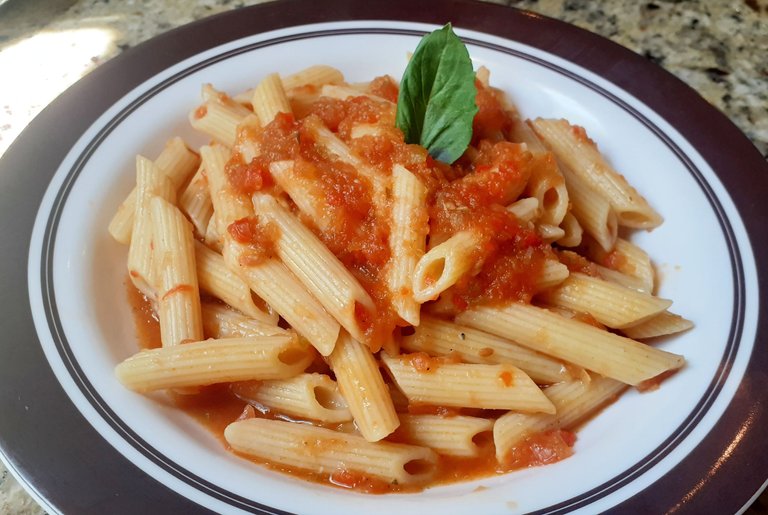

Ingredientes 🍅🍅🍝🍝
- 250 g de pasta
- 6 tomates
- 5 hojas de albahaca
- 2 cebolla
- 2 ajíes dulces
- 1 pimentón o pimiento
- 6 dientes de ajo
- Salsa de soja
- 1 cda (cucharada) de aceite
- 1 cda de margarina
- Sal
- Pimienta
Ingredients 🍅🍅🍝🍝
- 250 g pasta
- 6 tomatoes
- 5 basil leaves
- 2 onions
- 2 sweet peppers
- 1 paprika or bell pepper
- 6 garlic cloves
- Soy sauce
- 1 tbsp oil
- 1 tbsp margarine
- Salt
- Pepper

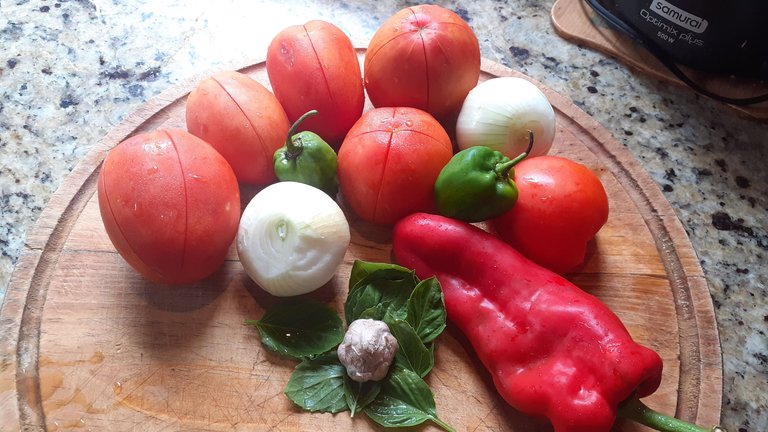

Comenzamos escaldando los tomates. Este proceso es muy fácil, ya que comienzas colocando una olla donde entren los 6 tomates, esta debe llenarse más arriba de la mitad con agua. Posteriormente, quita la parte del tallo con un cuchillo y luego hazle dos incisiones de forma longitudinal partiendo desde el tallo; una vez el agua este bien caliente coloca los tomates hasta que puedas apreciar que la piel del tomate empieza a despegarse.🍅🍝🥘
Start by blanching the tomatoes. This process is very easy, since you start by placing a pot where the 6 tomatoes will fit, this should be filled more than half full with water. Afterwards, remove the part of the stem with a knife and then make two longitudinal incisions starting from the stem; once the water is very hot place the tomatoes until you can see that the skin of the tomato begins to peel off.🍅🍝🥘

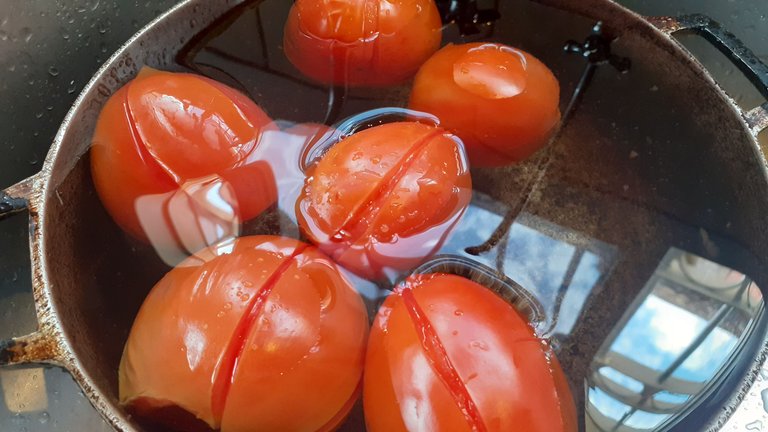

Llegado a este punto, baja el fuego y pasa los tomates por agua fría. Esto hará que se detenga la cocción de los mismos y sean mucho más manejables al quitarles la piel. Este proceso se hace porque la piel del tomate generalmente tiene mucha acidez y créeme que no quieres una salsa tan ácida, por lo que ya con lo que nos aportan sus semillas está bien. Cabe destacar que, si no quieres que la salsa sea ni un poco ácida, también puedes retirar la mayor cantidad de semillas posible.
El agua de la cocción de los tomates no la deseches porque se usará más adelante.
At this point, lower the heat and run the tomatoes under cold water. This will stop the tomatoes from cooking and make them much more manageable by removing the skin. This process is done because the skin of the tomato usually has a lot of acidity and believe me you do not want a sauce so acidic, so already with what they bring us their seeds is fine. It is worth noting that if you don't want the sauce to be even a little acidic, you can also remove as many seeds as possible.
Do not discard the water from cooking the tomatoes because it will be used later.

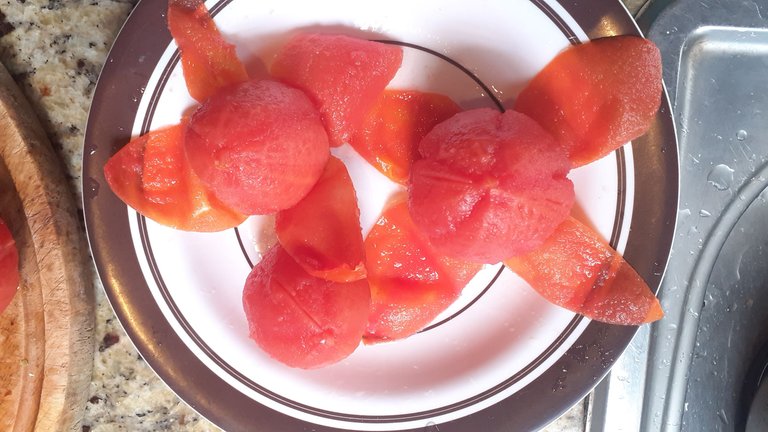

Después de pelar los tomates resérvalos a un lado y comienza a cortar los vegetales faltantes picándolos en mirepoix, el cual es el término para un corte bien grueso, sin forma ni estilo, como si fuera para una sopa :D.
After peeling the tomatoes set them aside and start chopping the remaining vegetables by chopping them in mirepoix, which is the term for a very thick cut, without shape or style, as if for a soup :D.

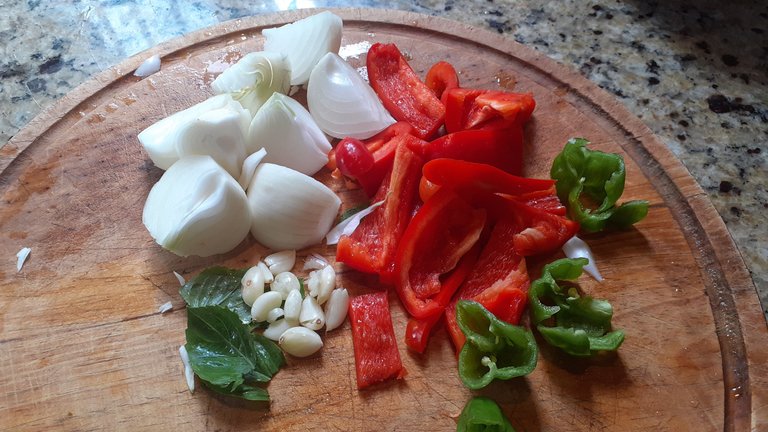

Seguidamente empieza a licuar por partes los vegetales y los tomates. Primero licúa los vegetales, en este momento usa parte del agua que has reservado anteriormente, siendo la cantidad adecuada la justa hasta cubrir los vegetales en la licuadora.
Nota Importantísima 🔥 : En este punto te recomiendo que, si el agua aun está muy muy caliente, trates de enfriarla un poco, ya que si tratas de licuar con agua muy caliente puedes causar un accidente debido al vapor generado más la fuerza de la licuadora, lo que hará una especie de volcán. Así que, por favor, tener cuidado.
Next start blending the vegetables and tomatoes in parts. Blend the vegetables first, at this point use part of the water that you have previously reserved, being the right amount to cover the vegetables in the blender.
Very Important Note 🔥: At this point I recommend that, if the water is still very hot, try to cool it down a little bit, because if you try to blend with very hot water you may cause an accident due to the steam generated plus the force of the blender, which will make a kind of volcano. So please be careful.

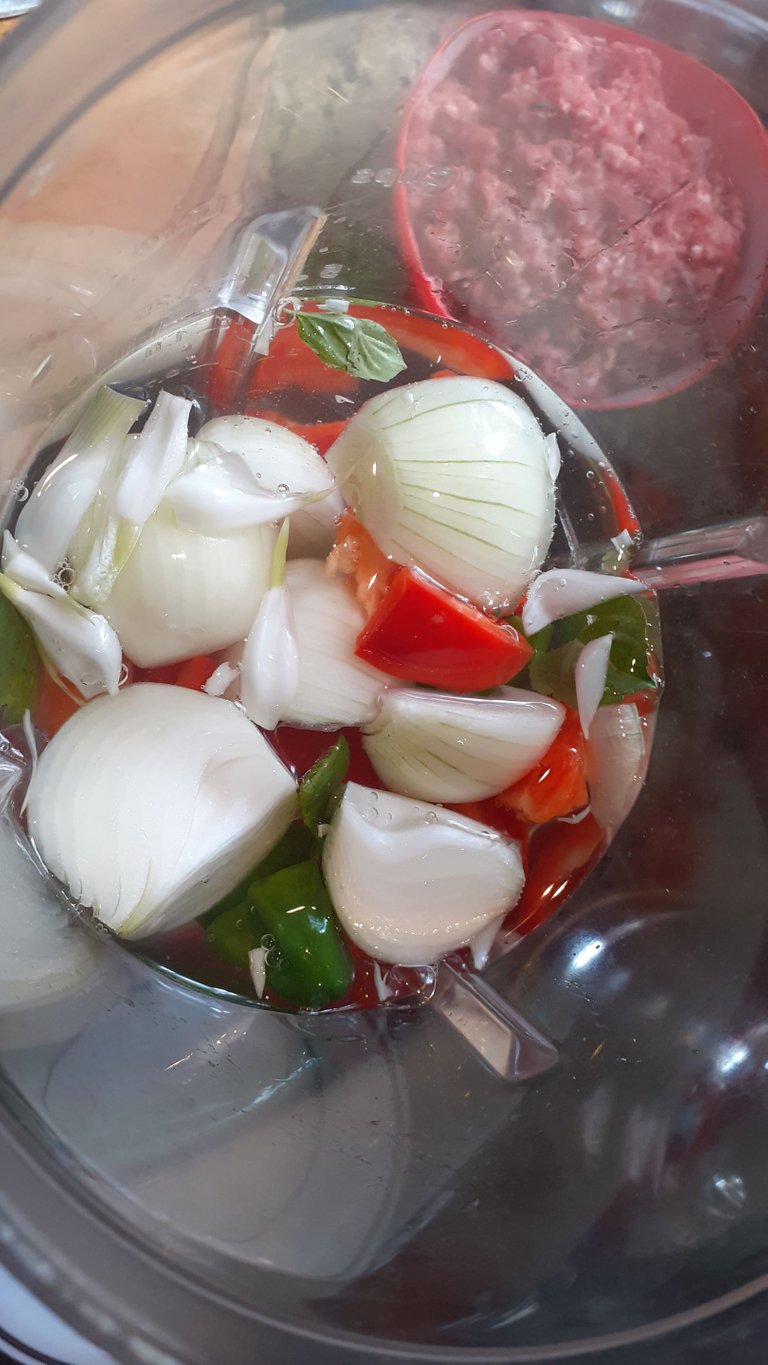

Una vez licuados, monta dos ollas a fuego alto, una con el agua restante que quedó de la cocción de los tomates y una cucharadita de sal, la cual se usará para cocinar la pasta…
Nota 🔥 : Se debe tratar que la pasta quede un poco antes del término al dente, porque la terminarás de cocinar con la misma salsa. Así que, una vez llegue a este punto, la reservas hasta que la salsa esté lista
…y otra olla en donde colocarás el aceite y la margarina con los dientes de ajo machacados y 2 hojas de albahaca.
Once liquefied, assemble two pots over high heat, one with the remaining water left from cooking the tomatoes and a teaspoon of salt, which will be used to cook the pasta...
Note 🔥 : You should try to cook the pasta a little before the end of al dente, because you will finish cooking it with the same sauce. So, once it reaches this point, put it aside until the sauce is ready.
...and another pot where you will put the oil and margarine with the crushed garlic cloves and 2 basil leaves.

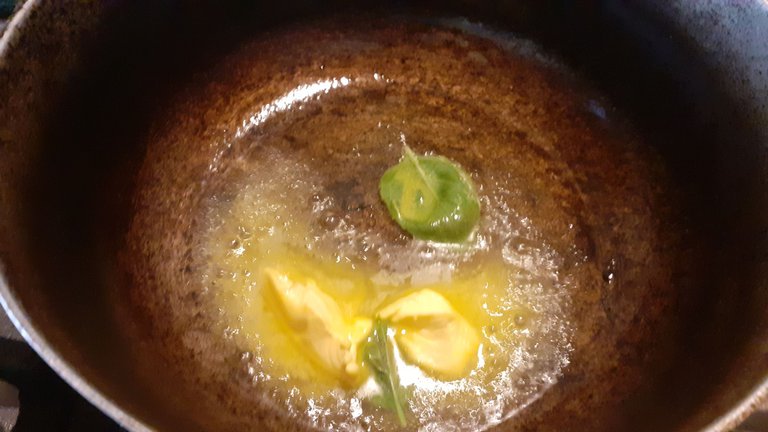

Procura entonces pasar 30 segundos revolviendo sin dejar quemar el ajo, entonces coloca los vegetales licuados, 1 cucharadita de sal, pimienta al gusto y 1 cucharada de salsa de soja y revuelve por 1 minuto para ir integrando todo.
Stir for 30 seconds without burning the garlic, then add the liquefied vegetables, 1 teaspoon of salt, pepper to taste and 1 tablespoon of soy sauce and stir for 1 minute to integrate everything.

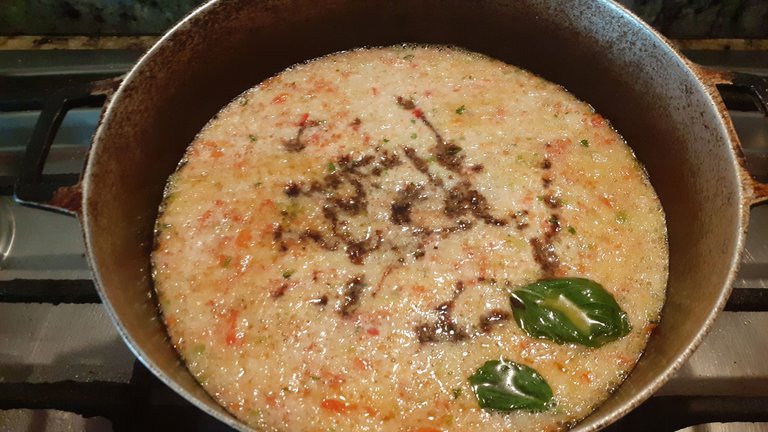

Ahora, procede a licuar los tomates. He de resaltar que a los tomates no se les agrega agua, con su mismo jugo será suficiente para poder licuarlos
Now, proceed to blend the tomatoes. I must emphasize that no water is added to the tomatoes, their own juice will be enough to blend them.

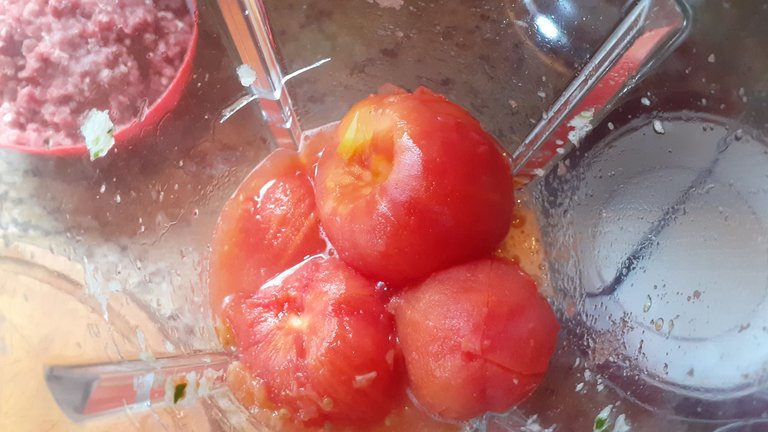

Luego de licuarlos los viertes en la olla donde pusiste los demás ingredientes y revuelve de 5 a 10 minutos, debes ir probando a ver si le falta sal, por lo que, en dado caso que le falte, le irás agregando hasta el punto que desees.
After blending them, pour them into the pot where you put the other ingredients and stir for 5 to 10 minutes, you should be testing to see if it lacks salt, so, in case it lacks salt, you will add it until the desired amount is reached.

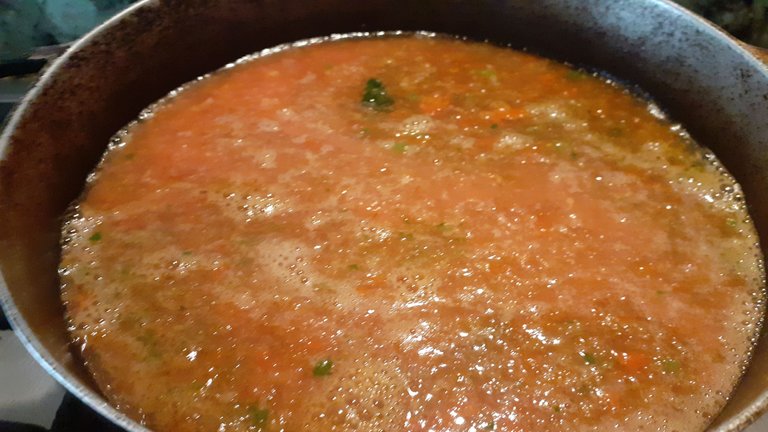

Finalmente, deja que hierva por unos 25 minutos. Pasado este tiempo, bajamos la llama y la colocamos a baja – media y esperamos a que reduzca.
Nota 🔥 : se tiene que ver que se evapore suficiente líquido, aunque no completamente y vaya agarrando cuerpo y espesor además de una especie de burbujeo en la superficie espesa.
Finally, let it boil for about 25 minutes. After this time, lower the flame and place it at low - medium and wait for it to reduce.
Note 🔥 : you have to see that enough liquid evaporates, although not completely, and it will take body and thickness as well as a kind of bubbling on the thick surface.

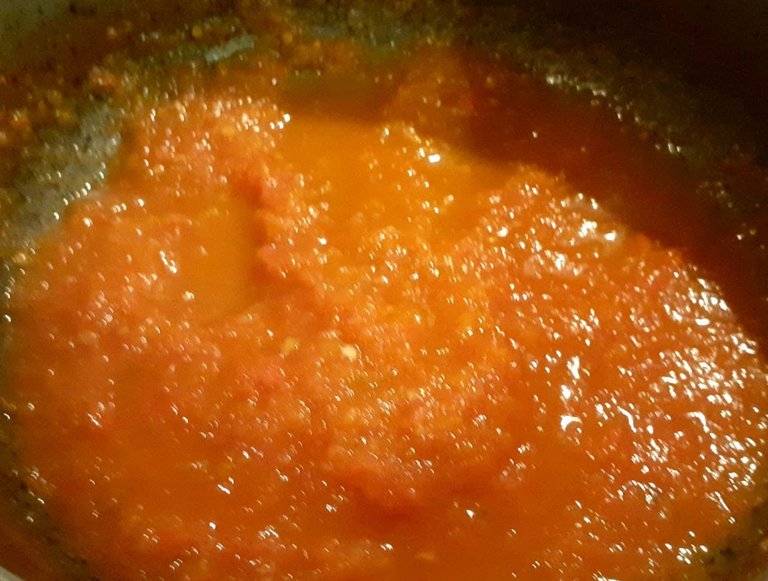

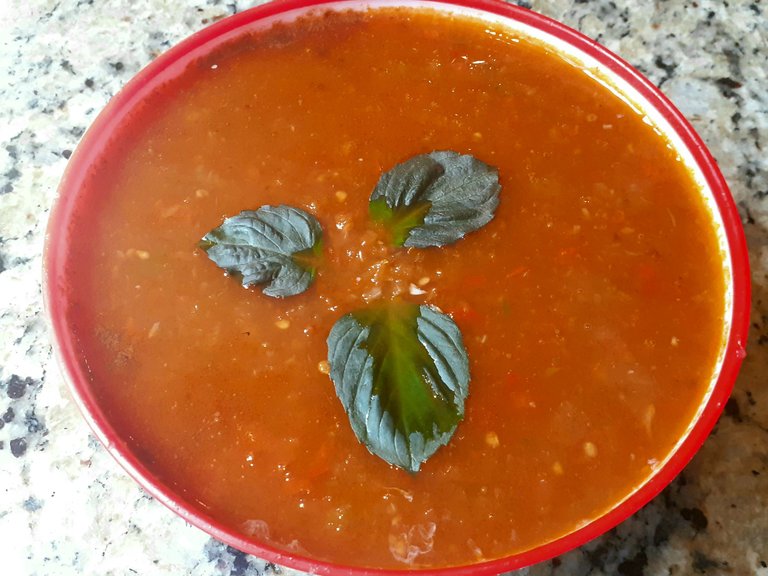

Para este punto ya deberías tener la salsa lista, ahora solo falta integrarla con la pasta, así que solo agarras la pasta y la colocas en la olla de la salsa y con el fuego medio – bajo revuelve e integra por 1 minuto para finalmente apagar la candela y tapar por unos 7 minutos. Esto terminará de cocinar la pasta e igualmente la salsa se impregnará en la misma.
Nota: recordemos que la pasta no la terminas de cocinar completamente, sino que la dejas como a un término medio. Esto se hace de esta manera para que se pueda terminar de cocinar con su misma salsa, ya que, si cocinamos completo la pasta y luego se pasa a la salsa caliente, quedará muy pasada de cocción.
Ya pasados los 7 minutos, estamos con la boca hecha agua, así que servimos con un poco de queso parmesano y unas hojitas de albaca bien picaditas. ¡A comer!…
At this point you should already have the sauce ready, now you just need to integrate it with the pasta, so just take the pasta and place it in the sauce pot and with medium-low heat stir and integrate it for 1 minute and finally turn off the heat and cover for about 7 minutes. This will finish cooking the pasta and the sauce will soak into the pasta.
Note: remember that you do not finish cooking the pasta completely, but leave it at a medium temperature. This is done in this way so that it can be finished cooking with its own sauce, since, if we cook the pasta completely and then pass it to the hot sauce, it will be very overcooked.
After 7 minutes, our mouths are watering, so we serve with a little parmesan cheese and some chopped basil leaves. Let's eat!...



- Las imágenes de este post fueron tomadas por mi mientras hacia la ejecución del platillo.
The images in this post were taken by me while I was doing the execution of the plate
Translated with Deelp

que delicia
@jotaefe0410 . Gracias por compartir. Yo hago un queso madurado con café que le debe quedar buenísimo a esas pastas.Exito
guao interesante, siempre he pensando en aprender hacer queso, yo amo el queso jajaja aunque a veces en cantidad es malo para la salud pero igual el queso guayanes es la gloria, espero poder aprender en algun momento...
gracias por comentar y recordarme una de mis metas :D
ahi te lo dejo. https://peakd.com/hive-152524/@juberth1983/engesp-matured-cheese-with-coffee